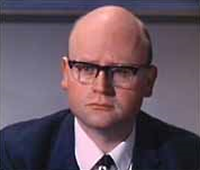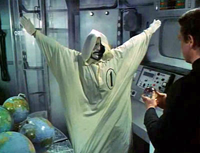 The Prisoner: About The Prisoner
The Prisoner: About The Prisoner The Prisoner: About The Prisoner
The Prisoner: About The Prisoner On the 1st of October 1967, the British Broadcasting Company screen the first episode of The Prisoner.
On the 1st of October 1967, the British Broadcasting Company screen the first episode of The Prisoner.
As the theme music starts, the opening sequence - which is to be repeated in all but two of the 16 episodes to follow - shows a man driving past the Houses of Parliament. He turns his car into an underground car park, storms down a corridor, throws open the doors of an office, and shouts at the man sitting behind the desk inside. He slaps an envelope on the desk addressed 'Private — Personal — By Hand', smashes his fist down on the desk, leaves, and drives home.
He begins throwing clothes into a suitcase, with pictures of a tropical resort: suggesting he is preparing for a holiday. But outside his house, a black hearse pulls up, and a pallbearer gets out, approaches the door, and presses the tip of an umbrella to the keyhole. A cloud of white smoke is shown filling the room, and the man inside collapses and loses consciousness.
He wakes in what seems to be his apartment, but in fact it proves to be an exact replica, as the view through the window is not of London, but of a mysterious and picturesque village...
As the story unfolds, we learn that our hero was a British agent: but that the letter he delivered was his resignation. He has been abducted and brought to a place known only as The Village, whose residents address each other not by name but by number: he is Number 6. The Village is governed by Number 2, played by a different actor each week though a couple make more than one appearance.
But each Number 2 has the same aim: to find out why the hero resigned his job.
And Number 6 has also only one aim: to escape.
In this, he is thwarted by various means: by omnipresent surveillance cameras, by Village residents spying on him for Number 2, but above all by Rover, a huge white ball, neither quite sentient nor quite mechanical, which roams the Village smothering and recovering runaways.
What is happening? Where is The Village? Which side runs it? Who is Number 1?
Who is The Prisoner?
 During the early 60s, actor Patrick McGoohan was starring as John Drake in a popular action series called Danger Man in the UK, but also broadcast as Secret Agent or Destination Danger abroad.
During the early 60s, actor Patrick McGoohan was starring as John Drake in a popular action series called Danger Man in the UK, but also broadcast as Secret Agent or Destination Danger abroad.
He chanced to stay in a Welsh resort village called Portmeirion. He later said: 'I thought it was an extraordinary place, architecturally and atmosphere-wise, and should be used for something; and that was two years before the concept came to me.'
 The concept was of a place to which former secret agents were taken to be interogated and controlled: with all the intrigue and anonymity which surrounds all stories of espionage, but perhaps also analogous to the way any of us live in everyday society. A similar idea had been present in an episode of Danger Man called Colony Three, in which John Drake infiltrates a prison community for spies established in Eastern Europe during the cold war: and Danger Man's script editor George Markstein (pictured) also recalled stories told by some World War II veterans of incarceration in a resort-like prison.
The concept was of a place to which former secret agents were taken to be interogated and controlled: with all the intrigue and anonymity which surrounds all stories of espionage, but perhaps also analogous to the way any of us live in everyday society. A similar idea had been present in an episode of Danger Man called Colony Three, in which John Drake infiltrates a prison community for spies established in Eastern Europe during the cold war: and Danger Man's script editor George Markstein (pictured) also recalled stories told by some World War II veterans of incarceration in a resort-like prison.
McGoohan took the idea to Lew Grade of ITC Entertainment, who provided funding, and created the series with the help of Markstein, writing a detailed description of The Village as backstory for the writers, writing and direct several episodes himself, and of course himself starring as The Prisoner.
 The Prisoner was one of the most fascinating and enigmatic series ever filmed: and its meaning has been the subject of controversy for forty years. When first broadcast, the series attracted huge debate, and many viewers tuned into the last episode hoping for clear, simple answers. They didn't get them. Patrick McGoohan records:
The Prisoner was one of the most fascinating and enigmatic series ever filmed: and its meaning has been the subject of controversy for forty years. When first broadcast, the series attracted huge debate, and many viewers tuned into the last episode hoping for clear, simple answers. They didn't get them. Patrick McGoohan records:
When they did finally see it, there was a near-riot and I was going to be lynched. And I had to go into hiding in the mountains for two weeks, until things calmed down. That's really true!
 Certain themes, though, do recur. The individual, his relationship with society, and the nature of freedom are central to many of the individual plots and, many think, to the series as a whole. The ability of the individual to think for himself, counterposed to the desire of government to control his thoughts, is a struggle frequently represented in episodes: as the prisoner is variously threatened, bribed, beaten, shamed, drugged and hypnotised in failed efforts to make him conform. And it is arguable that the series looks not just at interpersonal but intrapersonal struggle: at the tensions not only between the individual and society, but between the individual's moral and creative nature, and his own baser self.
Certain themes, though, do recur. The individual, his relationship with society, and the nature of freedom are central to many of the individual plots and, many think, to the series as a whole. The ability of the individual to think for himself, counterposed to the desire of government to control his thoughts, is a struggle frequently represented in episodes: as the prisoner is variously threatened, bribed, beaten, shamed, drugged and hypnotised in failed efforts to make him conform. And it is arguable that the series looks not just at interpersonal but intrapersonal struggle: at the tensions not only between the individual and society, but between the individual's moral and creative nature, and his own baser self.
In the end, though, you can only see the series, and answer this question for yourself. One of the few things that those who have done so agree on is that they would recommend it. So do we!